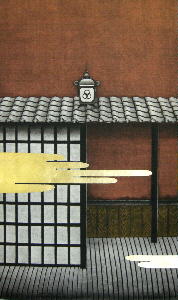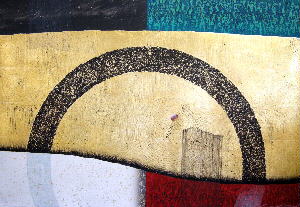The Orient Express…ions: Abstract and representational works reflecting
the current focus of Japanese artists
Featuring etchings, mezzotints, woodblocks and lithographs by:
Susumu Endo, Katsunori Hamanishi, Jörg
Schmeisser and Yoshikatsu Tamekane
|

Window-No.17
© 2008 Katsunori Hamanishi |
Where: Art & Frame and
The Williams Gallery
Dates: Saturday May 17 through Saturday, June 21, 2008
Opening Reception: Saturday May 17, 3:00 PM – 5:00 PM (free to the public)
Location:
12441
N. Highwway 14 Cedar Crest NM 87008
Phone: (954)
328-5341
Email:
wmbockfineart@gmail.com
Gallery Hours:
Mon. - Sat. 10:00 AM - 5:00 PM
|

Space & Space <Nature-0405>
© 2004 Susumu Endo |
|
|

A Navigator’s Dream
© 2007 Yoshikatsu Tamekane |
|
SUSUMU ENDO blends photographic and non-photographic processes via
computer, mixing the reality of the natural landscape with abstraction to create
a singular surrealistic image – a mingling of nature and a space continuum. Born
in 1933, Endo came to printmaking by way of graphic design. He uses the computer
as a tool to enhance and manipulate his already exquisite photographs and
drawings, which are then produced as lithographs.
Endo explains, "The source of my creative thoughts is to form
structural expressions in my mind space. There I layer several different
timelines into one, or construct a world where the real and unreal coexist and
interact. Though I work more on the computers these days, my fundamental
attitude toward my creations has remained mostly unchanged since the non-digital
age. The reason why I stick with a non-digital way of thinking is because it can
interact with my body and soul much more smoothly and naturally. At the same
time, I'm eager to take advantage of the latest technology and media for
creation. What I'm always trying to do is to explore a new relationship with
emerging media. This exploration continues to confirm the origin of my artistic
expressions."
Endo graduated from the Kuwasawa Design School in 1962 and then spent 5 years
in a small design studio. His art soon became recognized and after producing a
calendar for Audio-Technica, his images have appeared commercially and in the
collections of museums throughout Europe, the United States and Japan. His
images display a skill and beauty that challenge our sense of reality.
KATSUNORI HAMANISHI: Like the surrealistic paintings of
Dali and Magritte, Hamanishi's mezzotints combine nature and abstraction. Born
in Hokkaido, Hamanishi studied painting and graduated from Tokai University with
a degree in Art in 1973 and next studied at the University of Pennsylvania on a
grant from the Cultural Affairs Agency, 1987-88. He has won numerous prizes for
his work, including the Ibiza International Print Biennial, the Grenchen
International Triennial in Switzerland and the Valparaiso International
Exhibition in Chile.
Hamanishi’s subjects embody traditional Japanese symbols and images combined
with a contemporary interpretation. Few contemporary artist have the time and
patience to rock a plate with a mezzotint rocker long enough to produce the
velvety black impression so characteristic of the best work. Hamanishi explains:
"It is patience that is necessary to produce the jet-black texture
peculiar to mezzotint; the foundation of infinite tones from black to white.
This is similar to the grounding of an oil painting before the image is applied.
To prepare the copper plates may take 10 – 13 hours using a process called
‘burring". A comb-like tool is rocked methodically, vertically, horizontally and
diagonally over the plate until it is completely covered with impressions made
by its teeth. It is after the plate is burred that the drawing of the image into
the prepared surface begins."
Now living in the Tokyo area, Hamanishi’s primary focus is printmaking. His
works are in the permanent collections of the Metropolitan Museum and the MOMA
in New York; the Art Institute, Chicago; the Library of Congress, DC; Taipei
Fine Arts National Museum; Krakow National Museum; Osaka National Museum of Art;
and others. In September 2004 he was honored in a two-man show along with
venerated mezzotint artist Yozo Hamani at the Worcester Art Museum in
Massachusetts, where he presented a demonstration of his own techniques.
Jörg SCHMEISSER lives and teaches printmaking in Japan. His etchings draw
from locations in Japan, Angkor Wat, the Antarctic, Australia, the Himalayas and
other locations. His work is known for technical excellence, beauty and
precision of detail. Schmeisser was born in 1942 in Stolp, Pomerania, now
Poland; grew up and went to art school in Hamburg before moving to Japan for
postgraduate studies. He has established homes in Canberra, Australia and Kyoto,
Japan where he teaches and creates his work. Jörg Schmeisser’s etchings, often
done ‘in situ’, display a reverence for the forms and intricacies of nature and
culture married to an unrivaled technical prowess
. Many of the images demonstrate the artist’s fascination with landscape and
architecture, while others portray with great accuracy objects observed in
nature. His prints often include descriptive text, usually in German, which
becomes an integral part of the composition. A favorite Greek poem of the
artist, titled "Ithaka" provides a clue to his lifelong intent. Etchings
from Nara, Japan will be on display in the current show.
When you set out for Ithaka
ask that your way be long,
full of adventure, full of instruction
rich with all you have gained on the way
not expecting Ithaka to give you wealth
Ithaka gave you a splendid journey.
In his prints made in Nara, the stories that are inevitably connected
to the objects began to emerge. Asked about the print "Paper Gohei" Schmeisser
explained the use of these folded pieces of white paper hung on strings in the
shrine to mark off ‘special areas’ (sometimes sacred, but always more than
ordinary). In one shrine you may encounter fresh, crisp new gohei, and in
another they may be tattered and worn. Not because one shrine was better kept
than the other, but simply that one had been visited at different times in the
cycle of ceremonies or festivals. In the current exhibit, the etchings of the
shrines of Nara embrace the facades, interiors and the details of this
remarkable culture.
YOSHIKATSU TAMEKANE says; "I savor the past and also look
forward to the future as a time of hope and advancement for the human spirit."
Tamekane is known for his technical prowess combined with a unique mystical
aesthetic and vision. Essentially a woodblock printer, he adds
texture to his woodblock images using collagraphic techniques. Materials
such as string, resin, and paper are applied to the block in order to add relief
to the surface of the print. He also incorporates gold and silver leaf in many
of his works.
He uses handmade papers and water-based ink that allow him to manipulate
light as deftly as any impressionist. His prints are bold, iconic expressions of
the concepts the artist seeks to visualize. The passage of time, travel, special
relationships, and the miracle of life are all subjects of his works. His
images combine landscape, geometry, evocative organic forms, and a controlled
use of color and texture into eye-catching images that capture the imagination.
Born in 1959, Yoshikatsu Tamekane studied at Sokei Academy of Fine Arts in
Tokyo. From 1991 to 1994 he lived in Paris while studying art at the Musee
d’Orsay, the Louvre and the Centre Pompidou. He is a member of the Japan Print
Association and has shown seven consecutive years in the prestigious CWAJ Print
Show. He is known for his combination of technical prowess with a mystical
aesthetic and vision.
Home Page
| Artwork
| Framing
| Restoration
| Shows & Events
| Online Store
| Master Works
| Pioneers
| Princeton
Willard Page Collection
| William Bock's Fine Art Catalog Rasoniee
Contact Us
| About Us
| Art Links
This page is copyright ©1995 - 2025
William Bock Fine Art LLC
